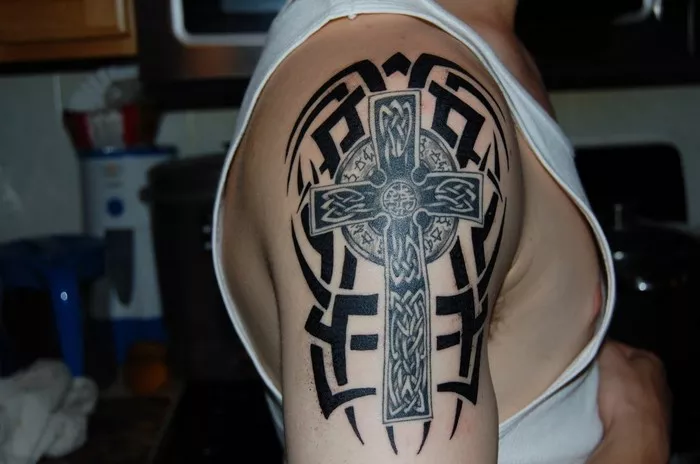Definition and Origin of Celtic Tattoos:
Celtic tattoos stand as intricate expressions of art, intertwining history, and culture into captivating designs etched onto the skin. Originating from the ancient Celtic tribes of Europe, these tattoos bear significant cultural and historical relevance, serving as a testament to the rich heritage of the Celtic people.
The origins of Celtic tattoos can be traced back thousands of years, to a time when Celtic tribes inhabited vast regions of Europe, including Ireland, Scotland, Wales, and parts of Britain and France. These tribes were known for their distinctive art style characterized by intricate patterns, interwoven knots, and symbolic motifs.
Symbolism and Meaning of Celtic Tattoos:
Central to the allure of Celtic tattoos is their profound symbolism, with each design carrying layers of meaning deeply rooted in Celtic culture and mythology. Knots, spirals, and interwoven patterns are hallmark features of Celtic designs, each imbued with its own significance.
Knotwork, with its endless loops and intricate crossings, symbolizes the interconnectedness of life and eternity, reflecting themes of continuity and unity. Spirals, another common motif, represent the cyclical nature of existence, with no beginning or end, signifying growth, transformation, and spiritual evolution.
Common meanings associated with Celtic tattoos include strength, resilience, and protection. The intricate patterns are believed to ward off evil spirits and bring good fortune to the bearer. Additionally, Celtic symbols often convey themes of heritage, identity, and the enduring bond between individuals and their Celtic roots.
Types of Celtic Tattoos:
The diversity of Celtic tattoo styles is a testament to the richness of Celtic artistry, offering a myriad of options for those seeking to adorn their bodies with these timeless designs. From traditional knotwork to iconic symbols drawn from Celtic mythology, the possibilities are as vast as the imagination.
One of the most popular styles of Celtic tattoos is knotwork, characterized by its elaborate interlacing patterns and geometric symmetry. Knotwork designs can vary in complexity, from simple knots to intricate, maze-like creations that mesmerize the eye.
Animals hold special significance in Celtic culture, often serving as symbols of strength, courage, and wisdom. Common animal motifs found in Celtic tattoos include the Celtic wolf, symbolizing loyalty and guardianship, and the Celtic stag, representing vitality and renewal.
Mythical symbols drawn from Celtic folklore also feature prominently in Celtic tattoos. The Celtic cross, with its distinctive ring surrounding the intersection of the crossbars, is a powerful symbol of faith, spirituality, and the eternal cycle of life and death. The Claddagh ring, with its heart, hands, and crown motif, is a beloved symbol of love, loyalty, and friendship.
The tree of life, with its roots reaching deep into the earth and branches stretching towards the heavens, is another popular motif in Celtic tattoos. Symbolizing the interconnectedness of all living beings and the cycle of life, death, and rebirth, the tree of life serves as a potent symbol of vitality, growth, and harmony.
Placement and Size of Celtic Tattoos:
When considering a Celtic tattoo, choosing the right placement is crucial for ensuring the design complements the body’s natural contours and proportions. Popular areas for Celtic tattoos include the arms, back, wrists, and ankles, where the intricate patterns can be showcased and appreciated.
The size of the tattoo is also an important consideration, influenced by personal preference, design intricacy, and desired visibility. Larger designs may be better suited for areas with ample space, such as the back or chest, allowing for the full expression of intricate details and motifs. Smaller tattoos, on the other hand, may be more suitable for areas like the wrist or ankle, where subtlety and discretion are desired.
Choosing a Design:
Selecting a Celtic tattoo design is a deeply personal process, guided by individual taste, cultural affinity, and personal significance. With a wealth of motifs and symbols to choose from, finding the perfect design can be both exhilarating and overwhelming.
One approach to selecting a Celtic tattoo design is to explore the rich tapestry of Celtic mythology and folklore, drawing inspiration from legendary figures, ancient symbols, and mythical creatures. Whether it’s the fierce courage of the Celtic warrior or the mystical allure of the Celtic faerie, there is no shortage of captivating motifs to ignite the imagination.
Consulting with a professional tattoo artist is also essential for bringing your Celtic tattoo vision to life. Experienced artists can offer valuable insights and recommendations based on their expertise in Celtic design and tattooing techniques. Collaborating with an artist who shares your passion for Celtic culture can result in a truly unique and meaningful tattoo that resonates with your individuality.
Aftercare and Maintenance:
Tattoo aftercare is essential for ensuring the longevity and vibrancy of your Celtic tattoo. Proper healing and hygiene practices can help prevent infection and promote optimal healing, ensuring your tattoo heals beautifully and retains its clarity and definition.
Following your tattoo session, it’s important to follow your artist’s aftercare instructions carefully, which may include keeping the tattoo clean and moisturized, avoiding exposure to direct sunlight, and refraining from swimming or soaking in water until the tattoo has fully healed.
Additionally, protecting your Celtic tattoo from sun exposure is crucial for preserving its colors and preventing fading over time. Applying a high-quality sunscreen with a high SPF to your tattooed skin whenever it’s exposed to the sun can help maintain the vibrancy and clarity of your tattoo for years to come.
In conclusion, Celtic tattoos are not merely ink on skin; they are profound expressions of heritage, symbolism, and artistry. With their intricate designs, rich symbolism, and deep cultural significance, Celtic tattoos serve as timeless tributes to the enduring legacy of the Celtic people, bridging the past with the present and inspiring future generations to embrace their Celtic roots.

